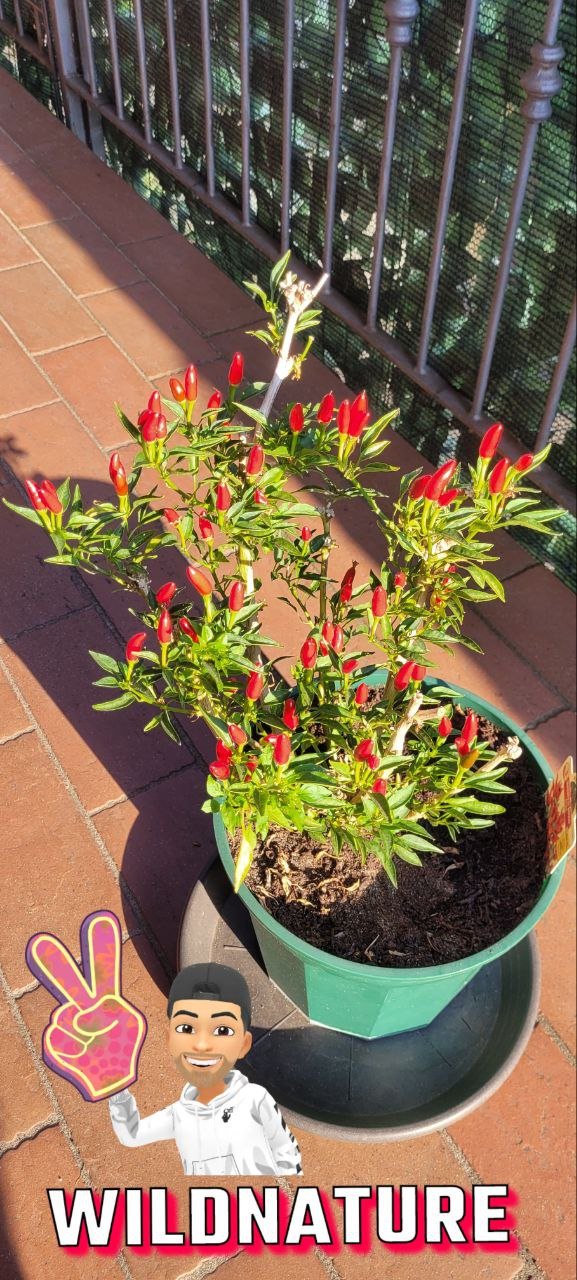Il Peperoncino 🌶️❤️
The English version follows in the end.
Versione Italiana 🇮🇹🇮🇹🇮🇹

Il peperoncino (Capsicum annuum), appartenente alla famiglia delle Solanaceae, è una pianta erbacea annuale o perenne, originaria dell'America Centrale e Meridionale. Coltivato in tutto il mondo, il peperoncino è apprezzato sia per il suo uso culinario, grazie al suo gusto piccante, che per le sue proprietà benefiche. Esistono molte varietà di peperoncino, con gradi di piccantezza che variano da leggeri a estremamente intensi, misurati con la scala di Scoville.
La pianta del peperoncino è compatta e ramificata, raggiungendo un'altezza compresa tra i 40 cm e 1 metro, a seconda della varietà e delle condizioni di crescita. Ha fusti eretti e foglie di colore verde scuro, di forma ovale o lanceolata. I fiori, che sbocciano generalmente tra la primavera e l'estate, sono piccoli e bianchi, spesso a forma di stella. Dopo l’impollinazione, si sviluppano i frutti, che sono bacche carnose di diverse forme e colori. Il peperoncino inizia di solito con una buccia verde, ma con la maturazione può virare al rosso, giallo, arancione, viola o persino nero, a seconda della varietà.
La pianta del peperoncino ama il sole e richiede temperature calde per crescere rigogliosa. Predilige terreni ben drenati, ricchi di sostanza organica e ha bisogno di una costante irrigazione. Cresce bene sia in giardino che in vaso, e nelle regioni con inverni rigidi è consigliabile proteggerla dal freddo.
Uno degli aspetti più affascinanti del peperoncino è il contenuto di capsaicina, il composto responsabile della sua piccantezza. Oltre a stimolare il gusto, la capsaicina ha proprietà benefiche: può migliorare la digestione, stimolare il metabolismo e persino favorire la circolazione sanguigna. Tuttavia, l'uso eccessivo di peperoncino può risultare irritante per lo stomaco e le mucose.
Il peperoncino è molto usato in cucina. Può essere consumato fresco, essiccato, in polvere, o utilizzato per preparare salse piccanti, oli aromatizzati e piatti tipici di diverse tradizioni culinarie. È anche un ottimo conservante naturale grazie alle sue proprietà antibatteriche.
E voi, avete mai provato a coltivare piante di peperoncino nel vostro giardino? Preferite i peperoncini dolci o quelli super piccanti? Condividete nei commenti la vostra esperienza e lasciate un "like" se amate il peperoncino e la sua energia in cucina! 🌶️🔥👍
(Foto scattata da me) 📸
English version 🇬🇧🇬🇧🇬🇧

The chili pepper (Capsicum annuum), belonging to the Solanaceae family, is an annual or perennial herbaceous plant native to Central and South America. Grown worldwide, the chili pepper is valued both for its culinary use, thanks to its spicy flavor, and for its beneficial properties. There are many varieties of chili peppers, with spiciness levels ranging from mild to extremely intense, measured by the Scoville scale.
The chili plant is compact and branched, reaching a height between 40 cm and 1 meter, depending on the variety and growing conditions. It has upright stems and dark green leaves, oval or lance-shaped. The flowers, which generally bloom between spring and summer, are small and white, often star-shaped. After pollination, fleshy berries of different shapes and colors develop as fruits. Chili peppers usually start with green skin but can turn red, yellow, orange, purple, or even black as they mature, depending on the variety.
Chili plants love sunlight and require warm temperatures to thrive. They prefer well-drained soils rich in organic matter and need consistent watering. They grow well in both gardens and pots, and in regions with cold winters, it's recommended to protect them from the cold.
One of the most fascinating aspects of chili peppers is their capsaicin content, the compound responsible for their spiciness. In addition to stimulating taste, capsaicin has beneficial properties: it can improve digestion, boost metabolism, and even promote blood circulation. However, excessive use of chili peppers can irritate the stomach and mucous membranes.
Chili peppers are widely used in cooking. They can be eaten fresh, dried, powdered, or used to prepare hot sauces, flavored oils, and traditional dishes from various culinary cultures. They are also excellent natural preservatives due to their antibacterial properties.
Have you ever tried growing chili plants in your garden? Do you prefer sweet or super spicy chilies? Share your experience in the comments and leave a "like" if you love chili peppers and their energy in the kitchen! 🌶️🔥👍
(Photo taken by me) 📸
"Wow, @username! 🌶️👍 This post is like a breath of fresh air for any foodie or nature lover! I'm loving the in-depth info about chili peppers, from their spicy flavor to their beneficial properties and varieties. Your photos are stunning too! 😊 The English version makes it so easy for non-Italian speakers like me to understand and enjoy your content. 💡 I'd love to hear about your own experience growing chili plants or trying out new recipes featuring these amazing peppers. Have you got any favorite sweet or super spicy chili dishes? 🤔 Let's get the conversation started! 📣 P.S. Don't forget to vote for @xpilar.witness by going to https://steemitwallet.com/~witnesses. Your support helps keep our community thriving! 👍"
Thank you so much! 😊 I'm glad you liked the post. Chili peppers are a true passion of mine, both in the kitchen and the garden! I'm experimenting with new varieties this year and will share them in another post soon. Personally, I love spicy dishes, but sweet peppers have their charm too! 🔥 Do you have any particular variety that you prefer?